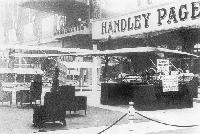M.Goodall, A.Tagg British Aircraft before the Great War (Schiffer)
Deleted by request of (c)Schiffer Publishing
WEISS Monoplane. 'Madge'
A pusher monoplane was built by Weiss, and was exhibited on the Handley Page stand at the Olympia Aero Show of March 1909. The stand bore a notice that a second machine was being built by Handley Page for the Weiss Aeroplane and Launcher Syndicate. The machine was priced at ?500 with a guarantee of flight, although it never did fly.
The machine was a single seater with Weiss type wing and was crudely constructed mainly of bamboo. The short nacelle housed the pilot in front of the engine and tapered to a point at the rear. There were no tail surfaces. The undercarriage consisted of a pair of curved skids for landing, with a separate four wheeled chassis, from which the machine was to detach itself at takeoff. It had been tested at Fambridge late in 1908 using rails and a pylon, as had the Wright brothers, but without success.
The engine drove twin pusher propellers by chain and gearing at the trailing edges of the wing, at a reduction ratio of 3:1. Behind the propellers were 'righting planes', which could be independently operated by foot pedals, thus serving as both ailerons and elevators.
Power: 12hp Anzani three-cylinder air-cooled fan type semiradial driving two 6ft diameter pusher propellers.
Data
Span 34ft
Area 150 sq. ft (226 sq. ft also reported)
Weight 360 lb.
Weight allup 500lb.
P.Lewis British Aircraft 1809-1914 (Putnam)
Weiss Pusher Monoplane
In the same year as the Weiss Glider, a power-driven single-seat tailless monoplane designed on the same principles was built during 1909 by Weiss himself and was exhibited by Handley Page at the 1909 Olympia Aero Show, together with a notice stating that a second example was being built by Handley Page for the Weiss Aeroplane and Launcher Syndicate Ltd. The Weiss type of wing plan-form, with its curved, swept-back leading-edge, was used on the Handley Page Glider, the H.P.1, H.P.3, H.P.4, H.P.5 and H.P.6 Monoplanes and also on the H.P.7 Biplane. A short nacelle was mounted below the wings, and contained a three-cylinder Anzani developing 12 h.p. which was installed behind the pilot. Gearing and chain-drives linked the power unit to a pair of 6 ft. diameter propellers which were recessed in the trailing-edge of the wings, the elevators being fitted immediately behind them, level with the thrust-line. Bamboo was used in the structure of the fabric-covered fuselage. The landing-gear consisted of skids, but the machine took off from a jettisonable four-wheel carriage which, it was claimed, would face the wind automatically. A guarantee of flight was offered with the price of ?500, but the machine, named Madge after one of Weiss's five daughters, never managed to leave the ground. Span, 34 ft. Wing area, 226 sq. ft. Weight empty, 360 lb. Weight loaded, 500 lb.
Журнал Flight
Flight, March 27, 1909
FLYERS AT OLYMPIA.
Weiss (HANDLEY PAGE).
Readers of the "Flight" section of The Automoior Journal will recollect our description of the bird-like model monoplanes constructed by Mr. Weiss. The machine which Messrs. Handley Page exhibit at Olympia is a full-size flyer on the same lines, and has also been built by the inventor himself. Like most work which has been put together in this way, the flyer is naturally somewhat rough-and-ready in appearance, for practically the whole of the framework is built up of cane, and this is a material which does not lend itself very well to neat jointing.
The Weiss flyer is of the monoplane type, and is peculiar amongst such machines in having no tail whatever. Let into the rear edges of the main wings, however, are a pair of righting planes operated by pedals so that they can work in unison for ascending and descending, and in opposite directions for steering and righting. Another peculiarity of the construction of the wings is their double curvature at the tips, it having been found from the gliding experiments with the models that everything depends upon having this curvature absolutely correct. Propulsion is effected by two propellers placed between the righting planes and the rear edges of the main planes. These propellers are chain-driven from an engine which is situated immediately behind the pilot. The machine, although comparatively small in appearance, has a considerable extent of supporting surface. As yet no actual man-lifting flight has been accomplished.






